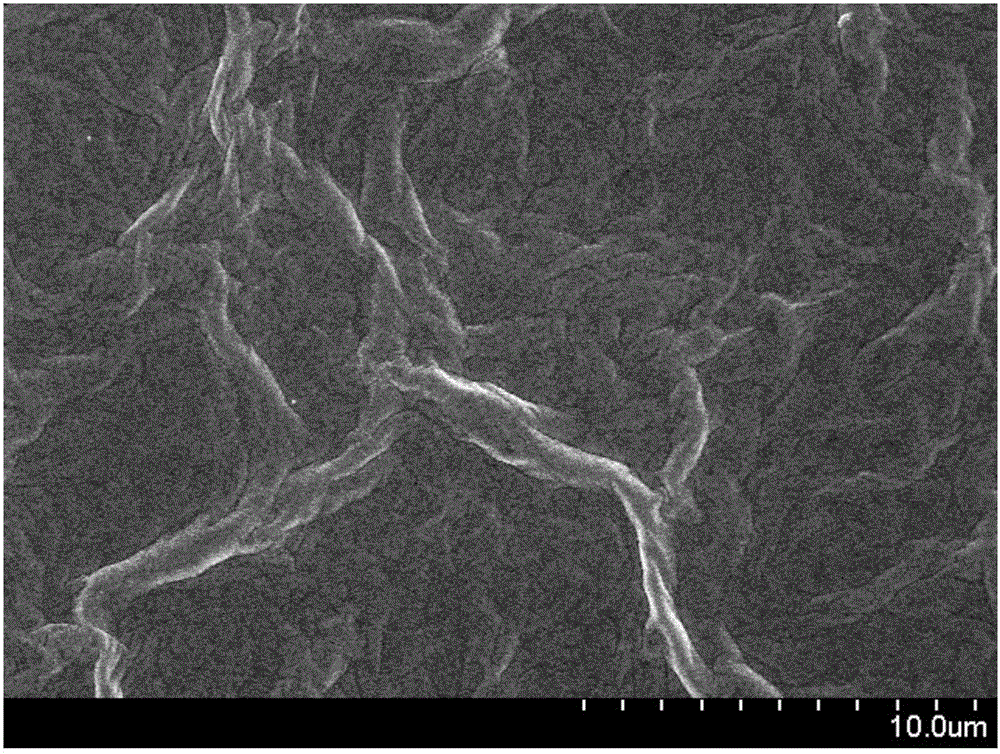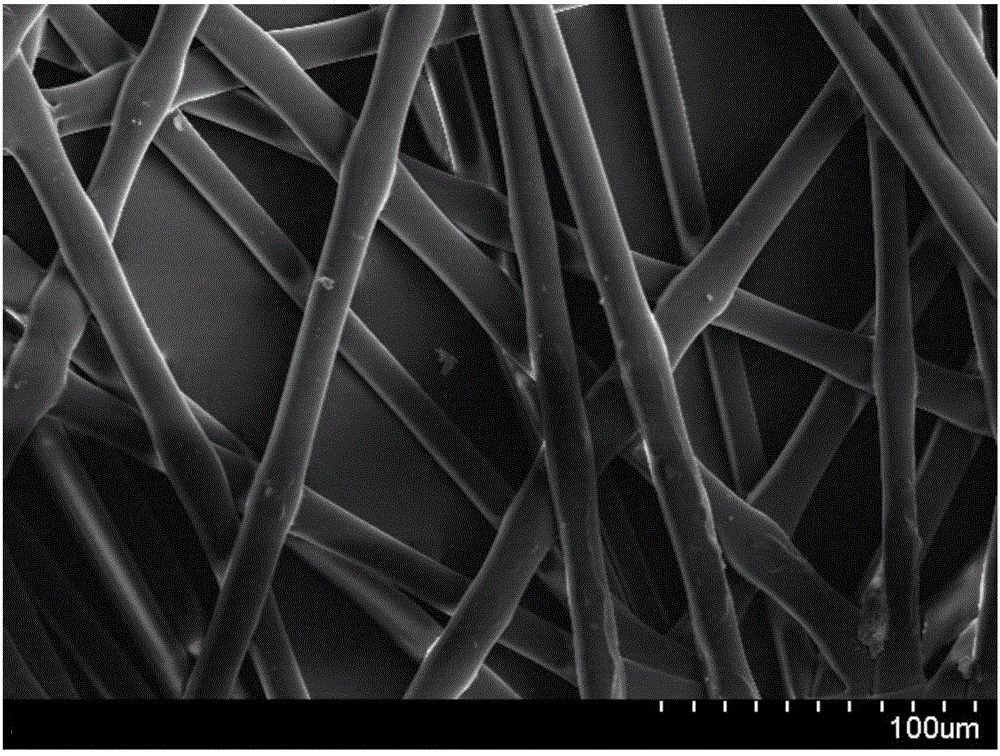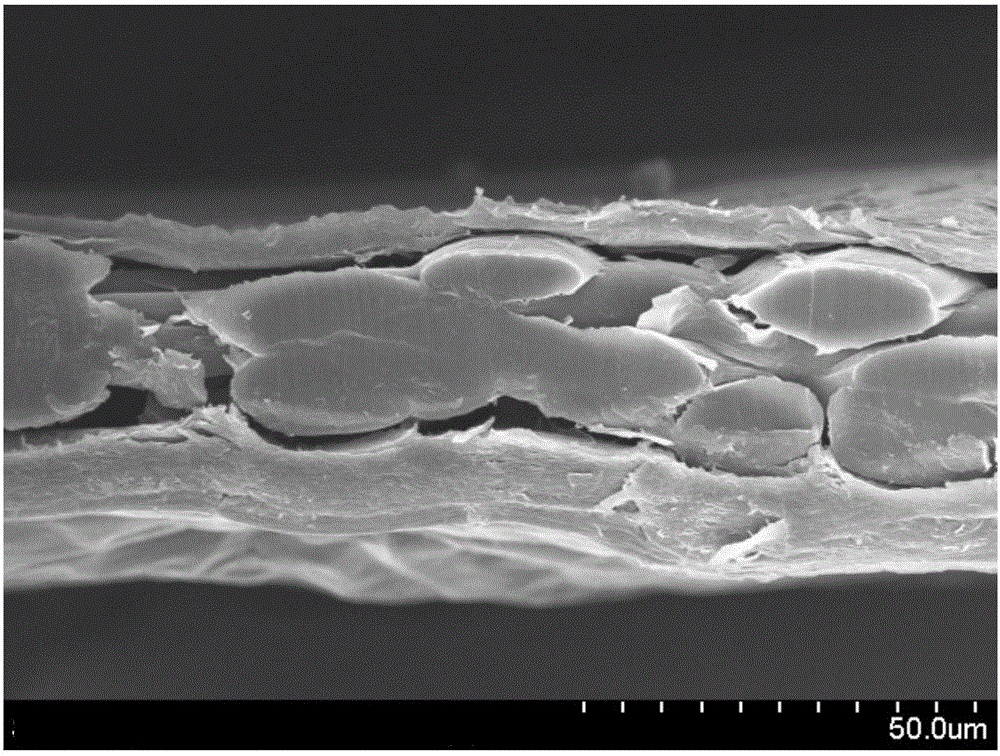Graphene oxide composite non-woven fabric and preparation method and application thereof
A graphene composite and non-woven fabric technology, applied in textiles and papermaking, electrical components, circuits, etc., can solve the problems of poor electronic conductivity and ionic conductivity, low electrical conductivity, and reduced ionic conductivity, etc., to prevent micro-short circuits , reduce the size, improve the effect of mechanical strength
- Summary
- Abstract
- Description
- Claims
- Application Information
AI Technical Summary
Problems solved by technology
Method used
Image
Examples
Embodiment 1
[0039] Put 1 g of graphene oxide into 20 g of a mixed solution of deionized water and ethanol (1:1, v:v) and stir magnetically for 5 h. Using polyvinylidene fluoride (PVDF) non-woven fabric as the base material, the obtained solution and the non-woven fabric base material are used to prepare graphene oxide composite non-woven fabric. The obtained slurry is evenly coated on one side of the PVDF nonwoven fabric, and the thickness of the coating layer is controlled at 3 μm. Preheat with an electric heating plate at 60°C, and after most of the solvent volatilizes, put it into a vacuum oven at 60°C to dry overnight to completely remove the solvent, and obtain a graphene oxide composite non-woven fabric (the graphene oxide composite non-woven fabric scanning electron microscope photo is shown in Fig. figure 1 shown).
Embodiment 2
[0041] Put 1 g of graphene oxide and 1 g of perfluorosulfonic acid resin into 50 g of a mixed solution of deionized water and ethanol (1:1, v:v) and stir magnetically for 10 h. Using polyethylene terephthalate (PET) non-woven fabric as the base material, the obtained solution and the non-woven fabric base material are used to prepare graphene oxide composite non-woven fabric. The resulting slurry is evenly poured inside the PET non-woven fabric, and the quality of the poured polymer is 5mg / cm 3 . Preheat at 60°C with an electric heating plate, wait for most of the solvent to volatilize, put it in a vacuum oven and dry at 60°C overnight to completely remove the solvent, and obtain a graphene oxide composite non-woven fabric.
[0042] figure 2 It is the scanning electron micrograph of the surface of PET non-woven fabric. image 3 It is the scanning electron microscope image of the cross-section of the graphene oxide composite non-woven fabric.
Embodiment 3
[0044] Put 0.5 g of graphene oxide and 0.5 g of polyacrylonitrile (PAN) into 100 g of a mixed solution of nitrogen methylpyrrolidone and acetone (1:1, v:v) and magnetically stir for 20 h. The obtained solution was coated on a polyethylene terephthalate (PET) non-woven fabric as a substrate. The resulting slurry is evenly poured inside the PET non-woven fabric, and the quality of the poured polymer is 10mg / cm 3 . Preheat at 60°C with an electric heating plate, wait for most of the solvent to volatilize, put it in a vacuum oven and dry at 60°C overnight to completely remove the solvent, and obtain a graphene oxide composite non-woven fabric.
[0045] Figure 4 It is a comparison chart of graphene oxide composite non-woven fabric and ordinary PE separator to prevent the penetration of polysulfide ions.
PUM
| Property | Measurement | Unit |
|---|---|---|
| Thickness | aaaaa | aaaaa |
| Thickness | aaaaa | aaaaa |
Abstract
Description
Claims
Application Information
 Login to View More
Login to View More - Generate Ideas
- Intellectual Property
- Life Sciences
- Materials
- Tech Scout
- Unparalleled Data Quality
- Higher Quality Content
- 60% Fewer Hallucinations
Browse by: Latest US Patents, China's latest patents, Technical Efficacy Thesaurus, Application Domain, Technology Topic, Popular Technical Reports.
© 2025 PatSnap. All rights reserved.Legal|Privacy policy|Modern Slavery Act Transparency Statement|Sitemap|About US| Contact US: help@patsnap.com



